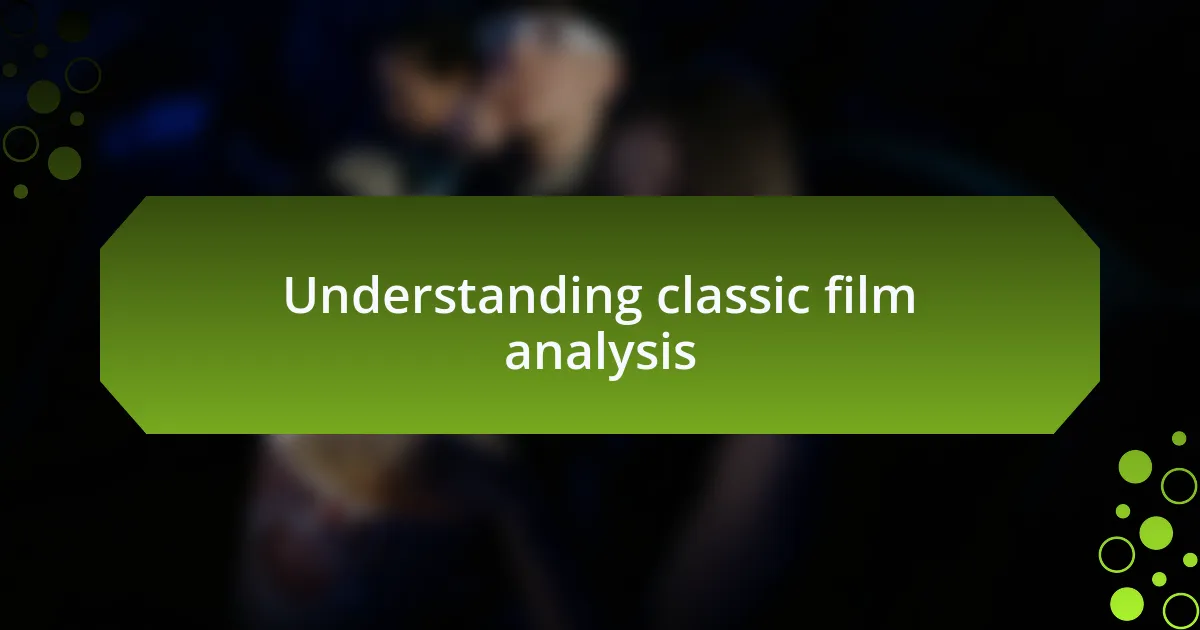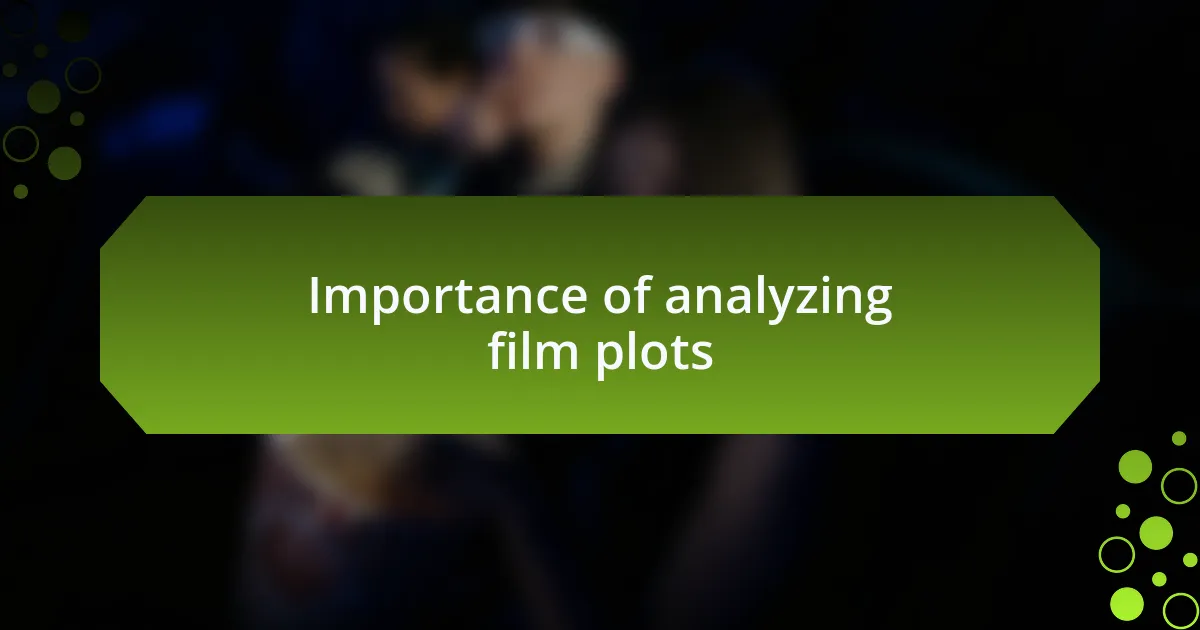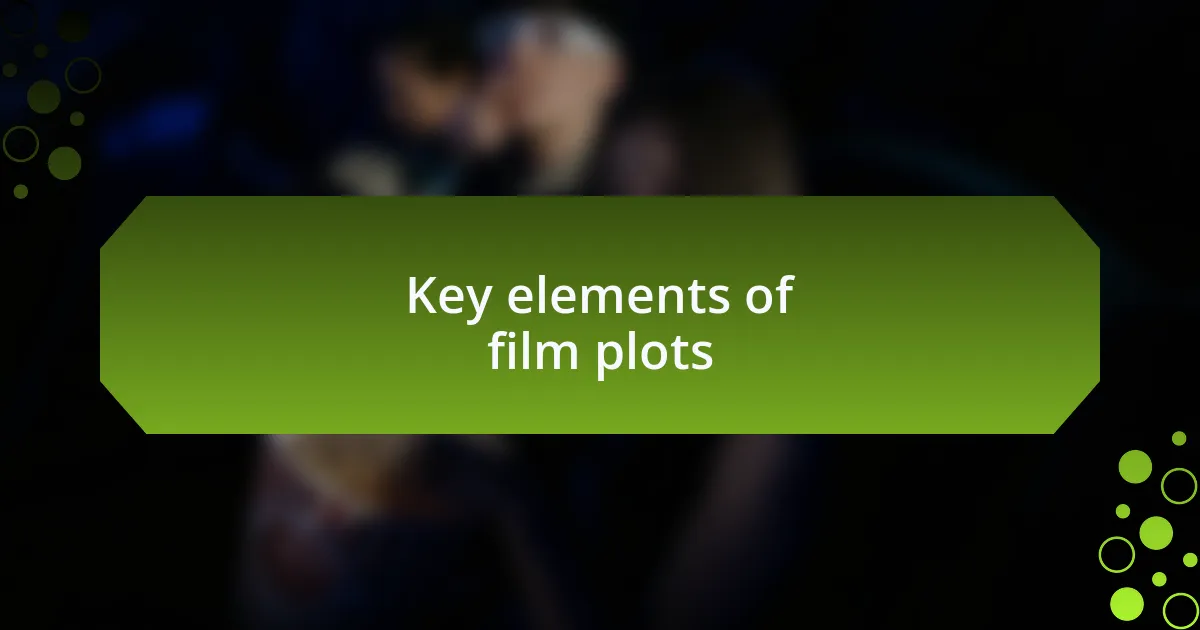Key takeaways:
- Understanding classic film analysis requires exploring character development, themes, and the cultural context of films like “Casablanca” and “The Godfather.”
- Key elements of film plots include character development, conflict, and setting, with examples from films such as “Gone with the Wind” and “The Wizard of Oz.”
- Effective plot analysis involves breaking down films into structure, themes, and symbolism, enhancing personal engagement and insights.
- Personal experiences and reflections, such as those from “The Graduate” and “Titanic,” deepen one’s connection to themes of identity and vulnerability in film.

Understanding classic film analysis
Understanding classic film analysis involves delving deep into not just the story, but the cultural and historical context that shapes it. I often find myself reflecting on why certain films resonate so profoundly with audiences across generations. Have you ever watched a classic film and felt an unexpected surge of emotion? It’s fascinating how these films capture the human experience in ways that remain relevant.
When I analyze classic films, I pay close attention to character development and the themes woven throughout the narrative. For instance, I recall watching “Casablanca” and feeling a deep empathy for Rick and Ilsa, not just as characters, but as representations of lost love and sacrifice during wartime. It made me question what I would sacrifice for love, drawing parallels to my own life experiences.
Moreover, the visual and auditory elements of classic films play a significant role in their storytelling. I remember being entranced by the golden age of Hollywood, where the cinematography and score worked harmoniously to create an unforgettable atmosphere. How does a haunting score change your perception of a scene? I believe it’s this interplay of elements that makes classic film analysis not just an academic exercise but a deeply personal journey.

Importance of analyzing film plots
Analyzing film plots is essential because it allows us to uncover the layers of meaning embedded in a narrative. I remember watching “The Godfather” for the first time, not just as a story about a crime family, but as an exploration of power, loyalty, and the American Dream. This deeper understanding transformed my viewing experience from passive consumption to active engagement.
When I reflect on film plots, I often find parallels between the stories and real-life experiences. For instance, analyzing the motivations behind the characters in “Psycho” led me to think about the complexities of human behaviors and societal norms. It’s intriguing how a horror film can evoke such reflections on identity and morality, encouraging us to question our own perceptions.
Moreover, studying the structure of classic films often reveals the clever storytelling techniques used by filmmakers. There was a moment while dissecting “Rear Window” when I realized how suspense is built through framing and perspective. Have you ever noticed how your viewpoint shapes your interpretation? This realization not only enhances my appreciation for cinematic art but also inspires me to look for deeper meanings in everyday life.

Popular classic films to analyze
When I think about classic films worth analyzing, “Casablanca” immediately comes to mind. The film is a masterclass in storytelling filled with themes of love, sacrifice, and moral ambiguity. I can still remember being captivated by the moment Rick had to choose between his own happiness and the greater good, which left me reflecting on the tough choices we face in real life. Have you ever been in a situation where you had to weigh your personal desires against what’s right for others?
Another classic that never fails to intrigue me is “Citizen Kane.” I was amazed by how Orson Welles used non-linear storytelling to shape our perception of the protagonist, Charles Foster Kane. Each layer peeled back felt like discovering a piece of a puzzle, leading to a deeper understanding of the complexities of ambition and loneliness. How does our own pursuit of success mirror Kane’s tragic journey? It prompts me to think about what truly brings happiness and fulfillment.
And then there’s “12 Angry Men,” a film that unfolds almost entirely in one room. The tension builds as the jurors deliberate, revealing not just the intricacies of the legal system but also the flaws of human nature. I remember feeling a mix of frustration and insight as biases were laid bare through the simple act of discussion. This film makes me wonder, how often do we allow our preconceived notions to dictate our decisions? Analyzing films like this helps me stay mindful of my own biases in daily life.

Key elements of film plots
When I dive into classic film plots, several key elements stand out. One significant aspect is character development; it’s like peeling back layers of an onion. I remember watching “Gone with the Wind” and realizing how Scarlett O’Hara evolves throughout the story, driven by her fierce determination. It makes me consider, how do the characters we see on screen mirror our own journeys of growth and resilience?
Another vital element is the conflict that drives the narrative. In classic films, this often revolves around internal struggles and moral dilemmas. Take “The Grapes of Wrath,” for instance. The Joad family’s fight against societal injustices resonated with me deeply, sparking thoughts about how conflicts, both personal and societal, shape our identities. Have you ever faced a conflict that challenged your core beliefs?
Setting also plays a crucial role in film plots, often acting as a character in its own right. A great example is “The Wizard of Oz,” where the transition from sepia-toned Kansas to the vibrant Land of Oz reflects the characters’ emotional journeys. I found myself often pondering how the environments we inhabit influence our own experiences and choices. What if our setting could transform us as dramatically as it did for Dorothy?

Methods for plot analysis
Analyzing a plot requires me to break it down into core components, starting with the structure. I often utilize the classic three-act structure—setup, confrontation, and resolution. For instance, in “Casablanca,” the tension builds beautifully as Rick grapples with past love and present sacrifice. It makes me reflect on how our own life stories often follow similar arcs, filled with choices that shape our paths.
Another method I find effective is thematic analysis. By identifying central themes, I understand how the film communicates deeper meanings. For example, in “12 Angry Men,” the theme of justice versus prejudice is front and center. I can’t help but think about how this theme resonates in today’s world—what does justice mean in our own lives, especially when bias clouds our judgment?
I also pay close attention to symbolism within the plots. Symbols enrich storytelling—like the rosebud in “Citizen Kane,” which embodies lost innocence and unfulfilled desires. This particular analysis reminds me of my own memories: how certain objects can trigger emotions and represent our past, making me question, what symbols in my life hold such weight?

Personal experiences analyzing film plots
When I dive into analyzing film plots, I often find myself reflecting on my childhood experiences. I remember watching “The Wizard of Oz” with my family, captivated by Dorothy’s journey. As I dissect the plot, I connect with her desire for home and belonging, triggering memories of my own childhood adventures and sense of longing.
One time, I sat down to analyze “The Graduate,” and its themes of existential confusion really hit home. The character’s struggle to find his place in the world mirrored my own doubts after graduating college. I couldn’t help but wonder—how many young adults face that pivotal moment when the path isn’t so clear? It’s a powerful reminder of the universal quest for identity.
In viewing films like “Psycho,” I often focus on the psychological aspects of character development. The complexities of Norman Bates intrigued me, especially after reading about the duality of his nature. I think about how people can present different sides of themselves, and I challenge myself to consider what lies beneath the surface in my own interactions. How often do we wear masks, concealing our true selves from the world?

Tips for effective film analysis
When analyzing films, I find that focusing on key themes gives depth to my understanding. For instance, while discussing “Casablanca,” I often reflect on the sacrifices characters make for love and principles. It makes me wonder, how far would I go for those I care about? This question colors my analysis and adds a personal touch to the viewing experience.
Another tip I use is to immerse myself in the historical and cultural context of the film. I recall watching “12 Angry Men” and realizing how the societal dynamics of the time influenced the story. Understanding that backdrop not only sheds light on the characters’ motivations but also helps me relate those historical truths to today’s world. Isn’t it fascinating how films can bridge gaps across decades?
Lastly, I believe personal connections enrich any film analysis. After watching “Titanic,” I thought about my own experiences with love and loss. I analyzed how the film portrays vulnerability amidst tragedy, allowing me to relate Rose and Jack’s journey to my life stories. I often ask myself—what emotions resonate with me from this narrative? This introspection fosters a more profound comprehension as I interpret the layers of the plot.